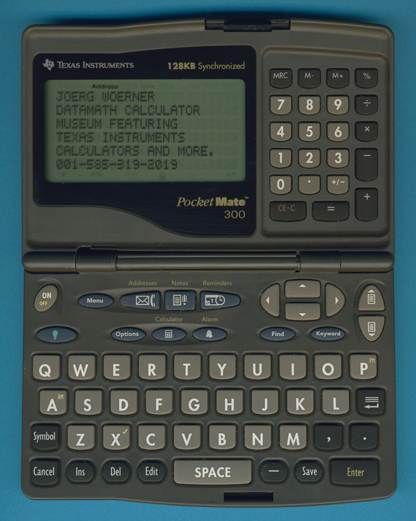
DATAMATH CALCULATOR MUSEUM
 |
DATAMATH CALCULATOR MUSEUM |
Texas Instruments PocketMate 300
| Date of introduction: | 1997 | Display technology: | LCD dot matrix |
| New price: | $199.99 | Display size: | 6 lines by 24 char |
| Size: | 3.3" x 5.1" x
0.70" 85 x 129 x 18 mm3 |
||
| Weight: | 5.1 ounces, 144 grams | Serial No: | 0089180 |
| Batteries: | 2*CR2032 | Date of manufacture: | mth 09 year 1997 |
| AC-Adapter: | Origin of manufacture: | Thailand (C) | |
| Precision: | 12 | Integrated circuits: | CPU: Toshiba T6M88 ROM: AB23512 RAM: Samsung KM681000 |
| Memories: | 128k Bytes RAM | ||
| Program steps: | Courtesy of: | Joerg Woerner |

![]()
 The
PocketMate series covers the models 100,120 and
140 sporting a small display and
the models 200, 300 and 400 with a very useful display
supporting 6 lines by 24 characters of crystal clear letters.
The
PocketMate series covers the models 100,120 and
140 sporting a small display and
the models 200, 300 and 400 with a very useful display
supporting 6 lines by 24 characters of crystal clear letters.
The PocketMate 200, PocketMate 300 and PocketMate 400 replaced within one year the similar PS-6760Si, PS-6860Si and PS-6960Si. The main differences are the enhanced keyboard layout with larger keys compared to the earlier models. The evolution of the Organizers could easily be explained.
| • PS-6700: Small keys, optional
PS-6155 Dock-station
cradle • PS-6760Si: Still small keys, added S (synchronize) and i (Indiglo). Synchronize links to the Lotus Organizer 97 software and Indiglo is the greenish night-light with an extra button. • PocketMate 300: Larger keys, and still the Si options. |
The PocketMate organizer keeps three main types of information: Reminders, Addresses and Notes. Within these three areas, there are many different ways to store and recall information. The huge memory of the PocketMate 300 with 128k Bytes size is flexible and could be divided without any limitations among the three files. In addition to the basic Organizer function you'll discover:
| • A flexible clock with 12-hour AM/PM or 24-hour time • A calendar from January 1960 to December 2059. • A calculator with 10-digits display capacity and 12-digits of accuracy • World time of 62 cities in all 24 time zones supporting one home city and 4 world cities • A backup battery |
 Dismantling
this PocketMate 300 manufactured in 1997 by Compal
Electronics in Thailand reveals no surprises. The printed circuit board
(PCB) looks very familiar to us and we identify the major components
immediately.
Dismantling
this PocketMate 300 manufactured in 1997 by Compal
Electronics in Thailand reveals no surprises. The printed circuit board
(PCB) looks very familiar to us and we identify the major components
immediately.
 The
hardware resembles more or less its predecessor PS-6860Si and is still centered
around a Toshiba T6M88 Application Specific CPU based on the 8-bit Z80
core.
The
hardware resembles more or less its predecessor PS-6860Si and is still centered
around a Toshiba T6M88 Application Specific CPU based on the 8-bit Z80
core.
 The
program memory is labeled AB23512 0063,
probably an OTP-ROM with a capacity of 64k
Bytes. We know the AB23512 already from the PS-6860Si, while the original PS-6700
makes use of the ATMEL
AT27C512 OTP-ROM.
The
program memory is labeled AB23512 0063,
probably an OTP-ROM with a capacity of 64k
Bytes. We know the AB23512 already from the PS-6860Si, while the original PS-6700
makes use of the ATMEL
AT27C512 OTP-ROM.
 The
data memory of the PocketMate 200, 300 and 400 is specified with 64k Bytes, 128k
Bytes resp. 256k Bytes - the layout of the printed circuit board (PCB) suggests
immediately the technical solution: The PCB accommodates one or two different
sized memory chips in a very flexible configuration, this PocketMate 300 hosts
one Samsung KM681000 chip sporting a capacity of 128k Bytes.
The
data memory of the PocketMate 200, 300 and 400 is specified with 64k Bytes, 128k
Bytes resp. 256k Bytes - the layout of the printed circuit board (PCB) suggests
immediately the technical solution: The PCB accommodates one or two different
sized memory chips in a very flexible configuration, this PocketMate 300 hosts
one Samsung KM681000 chip sporting a capacity of 128k Bytes.
 The most obvious design change from the PS-6760Si is the new configuration of
the two display drivers. While the PS-6860Si uses two driver chips in
Chip-on-Board (COB) technology on the Main-PCB, are they now located on an
additional PCB hosting the numerical keyboard.
The most obvious design change from the PS-6760Si is the new configuration of
the two display drivers. While the PS-6860Si uses two driver chips in
Chip-on-Board (COB) technology on the Main-PCB, are they now located on an
additional PCB hosting the numerical keyboard.

The PocketMate series was together with the Avigo 10 the last organizer in a
long line started with the PS-6200 and the simpler Mini Data
Bank. About one
year after the Organizer series was discontinued the TI-83
SE graphing calculator appeared with an integrated organizer function!
If you have additions to the above article please email: joerg@datamath.org.
© Joerg Woerner, January 17, 2002. No reprints without written permission.